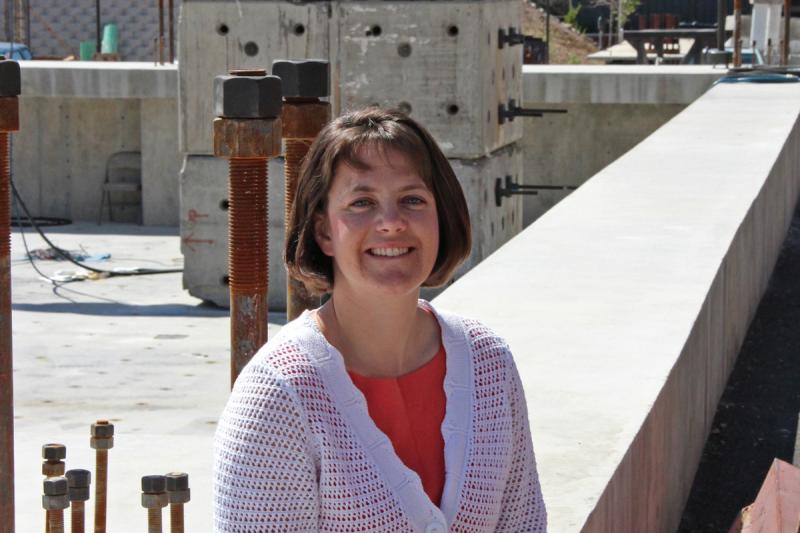You are here
Homeland Security Newswire - July 29, 2011

Keri Ryan, University of Nevada, Reno civil engineering professor and lead researcher for the base isolation tests this summer at the Hyogo Earthquake Engineering Research Center in Miki, Hyogo, Japan, sits at the outdoor portion of the University of Nevada Reno large structures earthquake engineering lab where they conduct world-renowned bridge research. Photo by Mike Wolterbeek, University of Nevada, Reno.
Landmark earthquake engineering tests this summer in Japan could open the door for earthquake-proofing technology applied to hospitals, nuclear power plants, and emergency-response facilities to be more common in the United States, and confirm the capabilities for the technology used in Japan and the rest of the world
Landmark earthquake engineering tests this summer in Japan by the University of Nevada, Reno could open the door for earthquake-proofing technology applied to hospitals, nuclear power plants, and emergency-response facilities to be more common in the United States, and confirm the capabilities for the technology used in Japan and the rest of the world.
The tests on the five-story 500-ton steel-frame building, supported by two different types of shock absorber base isolation systems, will be held on the 50-by-65-foot earthquake simulation “shake-table” at the Hyogo Earthquake Engineering Research Center, also known as E-Defense. The hydraulically activated table, the world’s largest, will exert several extreme earthquake motions to the building over a three-week period, said Keri Ryan, University of Nevada, Reno civil engineering professor and lead researcher for the project.
“These tests will represent the grandest showcase of the benefit of seismic isolation technology to date,” said Ryan, who travels to Japan this week to prepare for testing. “The primary objective of the tests is to demonstrate that damage-free performance can be targeted and achieved against an extremely rare earthquake anticipated to occur only every 2500 years on the West Coast of the United States.”
A University of Nevada, Reno release reports that the National Science Foundation (NSF) and Nuclear Regulatory Commission (NRC) have funded the base isolation research, which will help fill critical knowledge gaps, validate assumptions regarding behavior and modeling, and provide essential proof-of-concept evidence regarding the importance of base isolation technology.
“Base isolation devices have been around for decades, but new designs, materials and placement criteria enable us to use them in more applications,” Ryan said. “This testing will validate their use for large buildings, especially critical facilities such as hospitals, emergency response centers, places of public assembly, data centers, energy facilities, and critical bridge lifelines.”
Successful completion of these tests, the first of their kind, will make it feasible to have seismically-safe structures and will be a major step towards new regulations for use in nuclear power plants.
“Japan is very interested in the advanced design techniques used in our experiment to accommodate long duration, large movement subduction motions like the ones seen in the recent Tohoku earthquake and tsunami,” she said. “The entire world, the engineering community, will have access to the data as a proof of concept confirming the capabilities of this design and technology.”
She said the facility is one of the best shake table facilities in the world with the highest weight capacity for 3-D shaking. “The E-Defense facility specializes in testing large compact structures like buildings, storage tanks, etc., unlike our facility here at the University of Nevada, Reno,” she said. “With its multiple reconfigurable large shake tables, our University of Nevada, Reno facility is arguably the best in the world for multi-span bridge tests. We can test reduced scale buildings here, but for full scale buildings, the Japan facility is the best.”
The release notes that the steel-frame building will be supported on two different types of shock absorber base isolation systems. The first, triple friction pendulum isolators, provided by Earthquake Protection Systems, Inc. of Vallejo, California are designed to allow more than three feet of lateral motion. The second system, a combination of lead-rubber bearings and sliders provided by Dynamic Isolation Systems, of Sparks, Nevada. and their Japan partner, are designed for performance objectives specific to a nuclear power plant.
“We will also show how new base isolation systems can protect not only the buildings, but the contents and nonstructural systems — interior partition walls, suspended ceilings and piping systems – that routinely and catastrophically fail in large motion earthquakes,” she said. On one of the floors, a mock office will be constructed that will house furnishings and other contents. On the fourth and fifth floors the ceiling, piping and partitions systems will be installed for the test.
The nonstructural portion of the research is led by researcher and dean of the University of Nevada, Reno’s College of Engineering, Manos Maragakis.
Maragakis is lead investigator for the Grand Challenge project that is, for the first time, studying earthquake effects on non-structural elements within the buildings that will lead to enhancing the seismic performance of non-structural items.
The test facility is accessible to U.S researchers through the NEES/E-Defense collaborative program. Ryan’s team includes co-principal investigators Stephen Mahin of the University of California, Berkeley and Gilberto Mosqueda of theUniversity at Buffalo as well as graduate students and faculty from the University of Nevada, Reno. E-Defense staff researchers and faculty from Hokkaido University, Tokyo Institute of Technology and Kyoto University will also assist on the project.
http://www.homelandsecuritynewswire.com/earthquakes-scientists-will-shake-5-story-building-japan



Recent Comments